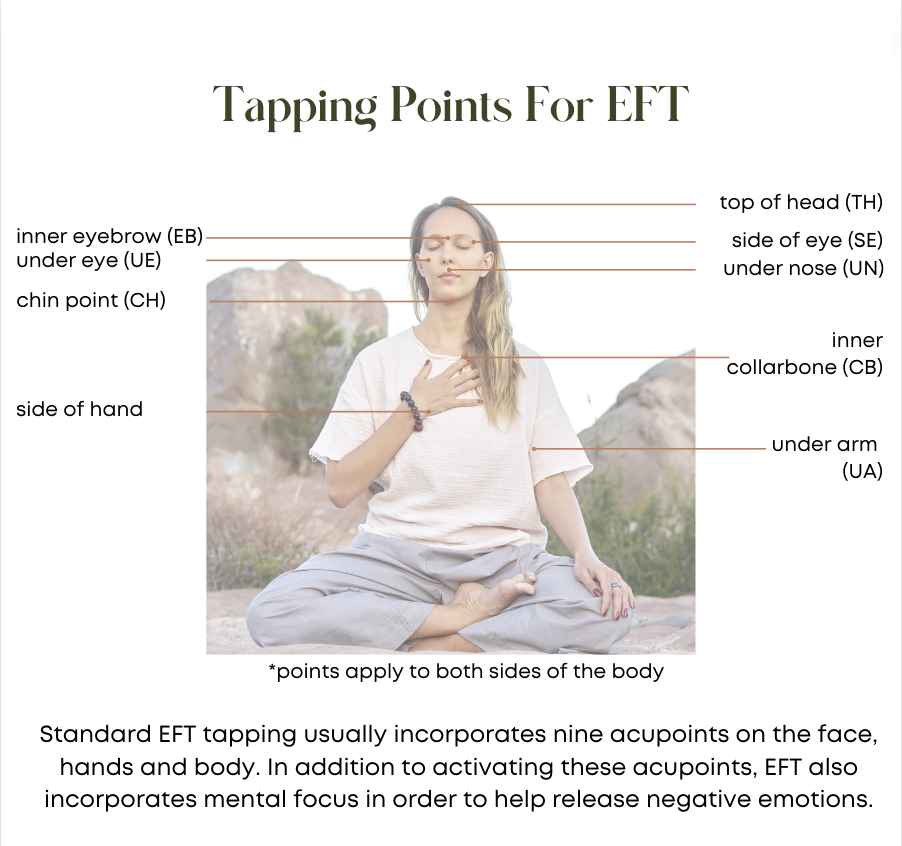What Is Tapping (AKA Emotional Freedom Technique) And How Can It Benefit You?
What Is Tapping (AKA Emotional Freedom Technique) And How Can It Benefit You?
An Overview
Tapping–also known as the Emotional Freedom Technique–is a holistic healing technique used to ease physical pain and a wide variety of emotional and mental health challenges. Tapping is based on principles of ancient Chinese medicine combined with modern psychology. According to Gary Craig, the developer of this technique, a disruption in energy is the cause of pain and problematic emotions and behaviours. Tapping balances the energy system helping to treat pain and distress.
How Does Tapping Work?
According to Chinese medicine, we all have energy hotspots in different areas of our body, known as meridian points. Energy flows through these points which helps to maintain good health. Unlike acupuncture which uses needles on the meridians, tapping consists of applying pressure using the fingertips on the key points. While tapping, one focuses on the negative emotions and physical sensations. Doing so helps calm the nervous system, restore the body’s flow of energy and rewire the brain to respond in healthier ways.
EFT may also help send signals to the part of the brain that controls our stress response. Accessing specific meridian points by tapping may reduce feelings of stress and/or negative emotions you are experiencing by restoring balance to any disrupted energy flowing through your body.
What Issues Does It Help With?
Research suggests that tapping can be noticeably helpful with a range of issues including:
Anxiety
PTSD
Pain and distress
Depression
Food cravings
It can also be a useful tool for children to recognize and manage their feelings of anxiety and anger.
EFT for Beginners
If you are new to EFT and want to try it at home, here's how you can start in five simple steps:
1. Identify the Issue
Identify the issue or negative emotion you are feeling. While tapping, try to focus intently on this as you go through each of the points.
2. Set an Initial Benchmark of Intensity
After you identify the issue you want to focus on, rate the intensity of it on a scale of 1-10 to make an assessment of your emotional or physical discomfort (10 being the highest or most difficult).
3. Establish a "Set-up Phrase"
Before you start tapping, establish a phrase that embodies the issue you're addressing in a positive way, i.e. “even though I have this issue, I deeply and completely accept myself.” When designing this phrase, there are two goals to keep in mind:
1) Acknowledge the problem
2) Fully accept yourself
4. Complete the EFT Tapping Sequence
EFT mainly focuses on the following nine meridians:
● Side of the hand: small intestine meridian
● Top of head (TH): governing vessel
● Eyebrow (EB): bladder meridian
● Side of the eye (SE): gallbladder meridian
● Under the eye (UE): stomach meridian
● Under the nose (UN): governing vessel
● Chin (Ch): central vessel
● Beginning of the collarbone (CB): kidney meridian
● Under the arm (UA): spleen meridian
Start by tapping the underarm point, and finish the sequence at the top of the head (TH). Remember to focus on your issue and emotions the whole time and use your set-up phrase at each meridian.
5. Assess Final Intensity
When you have completed the tapping sequence, rate your intensity level again on a scale from 1 to 10. Then, compare these results with your initial benchmark to note any differences. Repeat the process starting at step 1 if needed or desired.
Conclusion
In summary, EFT is a holistic technique that can be helpful when it comes to releasing negative emotions, easing anxiety and improving mental health. To learn more about EFT, or to book a free consultation with one of our therapists to see how it could benefit you, feel free to get in touch with us!


